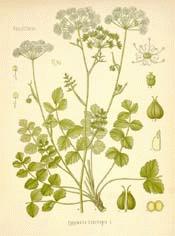
Botanical.com Home Page

|
Burnet, Lesser
(Pimpinella saxifraga)
Click on graphic for larger image
|
Burnet, Lesser
Botanical: Pimpinella saxifraga (LINN.)
Family: N.O. Umbelliferae
---Synonyms---Salad Burnet. Burnet Saxifrage. Pimpinella sanguisorba.
---Parts Used---Root, herb.
---Habitat---The Salad Burnet is common in dry pastures and by the wayside, especially on chalk and limestone, but is rarer in Scotland and Ireland than in England.
The Lesser or Salad Burnet is not unlike the Great Burnet in habit, but it is much smaller and more slender. It was known by older writers as Pimpinella sanguisorba, Pimpinella being a corruption of bipennula, from the two pinnate leaves. Pimpinella is now reserved for the name of a genus belonging to the order Umbelliferae, and the Salad Burnet is assigned to the genus Poterium, which name is derived from the Greek poterion, a drinking-cup, from the use to which the leaves of the Salad Burnet were applied in the preparation of the numerous beverages with which the poterion was filled in ancient times. The leaves when bruised smell like cucumber and taste somewhat like it, and it was used to cool tankards in the same manner as Borage, and was also added to salads and cups.
Hooker places both the Great Burnet and the Salad or Lesser Burnet in the same genus, Poterium, rejecting the generic name of Sanguisorba, assigned to the former by Linnaeus.
[Top]
---Description---Its leaflets are more numerous, five to ten pairs, and shorter than thoseof the Great Burnet. The flowers in each head bear crimson tufted stigmas, the lower ones thirty to forty stamens, with very long, drooping filaments. Both the flower and leafstalks are a deep-crimson colour.
- Turner (Newe Herball, 1551), in his description of the plant, tells us that
- 'it has two little leives like unto the wings of birdes, standing out as the bird setteth her wings out when she intendeth to flye. Ye Dutchmen call it Hergottes berdlen, that is God's little berde, because of the colour that it hath in the topp.'
The great Burnet and the Salad Burnet both flower in June and July.
The Salad Burnet forms much of the turf on some of the chalk downs in the southern counties. It is extremely nutritious to sheep and cattle, and was formerly extensively cultivated as a fodder plant on calcareous soils but is now little grown in that way. Cattle do not seem to like it as well as clover when full grown, but when kept closely cropped sheep are fond of it. It has the advantage of keeping green all the winter in dry barren pastures, affording food for sheep when other green crops are scarce. The results of cultivation have, however, not been very satisfactory, except on poor soil, although it contains a larger amount of nutritive matter than many grasses.
In the herb gardens of older days, Salad Burnet always had its place. Bacon recommends it to be set in alleys together with wild thyme and water mint, 'to perfume the air most delightfully, being trodden on and crushed.'
[Top]
---Cultivation---It is easily propagated by seeds, sown in autumn, soon after they are ripe. If the seeds be permitted to scatter, the plants will come up plentifully, and can be transplanted into an ordinary or rather poor soil, at about a foot distant each way. If kept clear from weeds, they will continue some years without further care, especially if the soil be dry. Propagation may also be effected by division of roots in spring or autumn.
When used for salad, the flower-stalks should be cut down if not required for seed. The leaves, for salad use, should be cut young, or may be tough.
---Part Used Medicinally---The whole herb, as in the Great Burnet, gathered in July and dried in the same manner.
---Medicinal Action and Uses---The older herbalists held this plant in greater repute than it enjoys at the present day. Pliny recommended a decoction of the plant beaten up with honey for divers complaints.
- Dodoens recommended it as a healer of wounds,
- 'made into powder and dronke with wine, wherin iron hath bene often quenched, and so doth the herbe alone, being but only holden in a man's hande as some have written. The leaves stiped in wine and dronken, doth comfort and rejoice the hart and are good against the trembling and shaking of the same.'
- Parkinson grew Burnet in his garden and the early settlers in America introduced it from the Mother Country.
- 'It gives a grace in the drynkynge,' says Gerard, referring to this use of it in cool tankards. We are also told that it affords protection against infection,
'a speciall helpe to defend the heart from noysome vapours and from the infection of the Plague or Pestilence, and all other contagious diseases for which purpose it is of great effect, the juice thereof being taken in some drink.'
and that
- 'it is a capital wound herb for all sorts of wounds, both of the head and body, either inward or outward, used either in juice or decoction of the herb, or by the powder of the herb or root, or the water of the distilled herb, or made into an ointment by itself or with other things to be kept.'
It is still regarded as a styptic, an infusion of the whole herb being employed as an astringent. It is also a cordial and promotes perspiration.
Turner advised the use of the herb, infused in wine or beer, for the cure of gout and rheumatism.
See:
LADIES MANTLE
PARSLEY PURT (PIERT).
Common Name Index
A MODERN HERBAL Home Page
Bear in mind "A Modern Herbal" was written with the conventional wisdom of the early 1900's. This should be taken into account as some of the information may now be considered inaccurate, or not in accordance with modern medicine.
© Copyright Protected 1995-2025 Botanical.com
|

